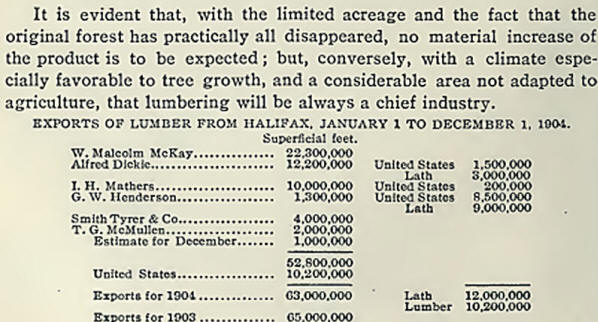|
Nova Scotia has
excellent shipping facilities. No part of the country is over sixty
miles from tide water, and numerous navigable rivers flow into the
Atlantic, Gulf of St. Lawrence and the Bay of Fundy. Three railway
systems, namely, the Intercolonial, the Dominion Atlantic and the
Halifax & Southwestern, are in operation and the rails extend the
whole length of the Province. The shipping points of the railways
are Sydney, Pictou, Pugwash, Windsor, Kingsport, Annapolis,
Weymouth, Yarmouth, Tusket, Bridgewater, Lunenburg and Halifax, from
which lumber is exported; and, besides these places, there are many
ports and harbors on the coast available for good sized vessels and
from which lumber is shipped. The bays and harbors indenting the
shore are very numerous, making the coast line about one thousand
miles in extent. The harbors on the Atlantic Coast have a good depth
of water and very little tide. The shipping ports on the Bay of
Fundy have strong tides, the rise and fall being from twenty-five to
forty feet. In many of these places vessels load lying aground, or
in the stream, where they can lie afloat, from barges and lighters.
At Ship Harbour,
Halifax County, there is thirty feet of water at the mills; at
Liscomb, twenty-two feet; at Sheet Harbour, twenty-eight feet; at
St. Mary’s River, seventeen feet, and at Bridgewater and Lunenburg,
seventeen feet. There is no better harbor in Canada than Halifax,
from which the annual export of lumber is over 60,000,000 feet —more
than that from all the other ports of the Province combined.
Particular stress
is laid upon the shipping conditions of Nova Scotia for the reason
that the Province depends entirely upon the export trade. The home
consumption is so light that it need not be taken into
consideration. Thus the small population or previously slow growth
of the Province, slow compared with that of other countries, has not
had the effect of conserving the timber. On the contrary, the
continued activity of the export trade of the last fifty years has
reached the stage where the annual cut of the Province has caught up
with the yearly growth.
Nova Scotia has the
following markets for its products: The United States, England,
Ireland, Scotland, France, West Indies, Cuba, Argentine Republic,
Brazil, British Guiana and Trinidad. Water transportation from
points in western Nova Scotia ranges from 300 to 500 miles to New
York, Boston and Philadelphia.
There are two grand
divisions to be made in considering the lumber exports of Nova
Scotia, brought about by trade conditions : The eastern end of the
Province ships almost entirely to the English deal market, and the
western end to South America, the West Indies and the United States.
The cut for the English market is three-inch deals, and that for the
West, boards, plank, rails and scantling. The deals are carried
largely by liners or tramp steamers, while the western part of the
Province engages a large fleet of sailing vessels from 150 to 1,000
tons register, a favorable size for the West Indies being a vessel
of from
300.000 to 400,000
capacity, and for South America, a vessel of from 500.000 to
1,000,000 capacity.
Summing up, Nova
Scotia may be said to possess the following specialties that are
peculiarly conducive to the carrying on of the lumber industry: It
has the nearest spruce timber for shipment to the European market;
it has a monopoly of the West Indian trade for cheap lumber; it has
a natural reproduction of woods that can not be excelled for
rapidity of growth and quality, owing to favorable rainfalls and
climatic conditions; its lumber fleet is largely owned in the
Province; the shipping facilities are excellent and inexpensive, and
the principal ports of shipment are open all the year around.
Among the leading
exporters of Nova Scotia are: Dickie & McGrath, Tusket; Parker,
Eakins Company, Limited, Yarmouth; Rhodes, Curry & Co., Limited,
Amherst; Alfred Dickie, Lower Stewiacke; Davison Lumber Company,
Limited, Bridgewater; the Nova Scotia Lumber Company, Walton;
Charles T. White, Apple River, and Clarke Bros., Bear River. The
average annual output of the latter firm is about 8.000.000 feet.
Alfred Dickie is an extensive operator having mills at Ship Harbour,
Lower Stewiacke and other points and owning 40,000 acres of timber
land, the standing timber on which is estimated at 40,000,000 feet.
The following
figures will give an idea of the extent of the lumber operations in
Nova Scotia and of the export: Total area of the Province. 21,428
square miles, or 13,713,920 acres; estimated timber and wood land,
7,500,000 acres; estimated export from western Nova Scotia,
110.000.000 superficial feet; estimated export from eastern Nova
Scotia, including Halifax shipments, 135,000,000 superficial feet;
total export, 245,000,000 feet per annum.
The total value of
the shipments of forest products from Halifax for the fiscal year
1903 was $1,048,160, which included spruce and other deals,
$746,591; planks and boards, $115,282, and scantling, $34,797.
The Canadian census
of 1901 gives the number of sawmills in Nova Scotia employing five
hands or more as 228, the value of the product being $2,940,107. The
quantities and values of forest products were as follows:




 |
